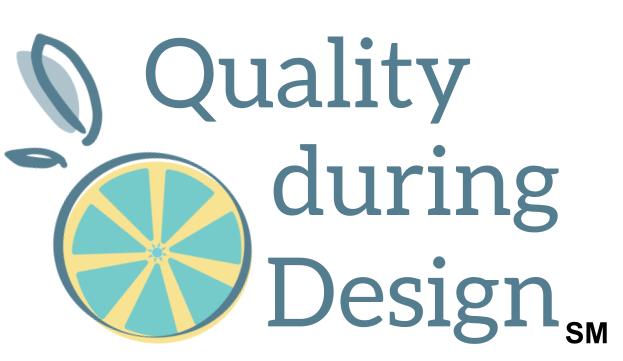Hi, it's Dianna. How can design engineers use the creativity of the cross-functional team to help develop a design concept? If we jump into engineering designs and creating prototypes, we've already missed out on an opportunity to develop something creative and innovative with our team. And let's be honest, that idea is likely better than anything we could have designed on our own. Design engineers can and should facilitate sessions with their team, but how do we do that? How do we get our cross-functional teams information about a new concept design, inviting them to a happy hour at Applebee's? We'll get people to show up and they might share some ideas about some new concept and new design ideas, but we're really not going to get the output that we are really looking for in order to engineer designs. Instead, we can use some frameworks. What we've been exploring in the previous six episodes of this podcast is using quality tools to further explore ideas, brainstorming, grouping, reducing, combining, and deciding which idea we should move forward with. So let's pull it all together. Let's pull together everything we've been talking about in the last six episodes, and I'll have steps that you can take as a design engineer, and I'll also give you a reminder of how what we've been covering fits into the big picture. You won't want to miss this episode because this is where it all happens and where you can step out from here.
Hello and welcome to Quality During Design, the place to use quality thinking to create products, others love for less. Each week we talk about ways to use quality during design, engineering, and product development. My name is Dianna Deeney. I'm a senior level quality professional and engineer with over 20 years of experience in manufacturing and design. Listen in and then join us. Visit quality during design.com.
Do you know what 12 things you should have before a design concept makes it to the engineering drawing board where your setting specifications. I've got a free checklist for you and you can do some assessments of your own. Where do you stack up with the checklist? You can log into a learning portal to access the checklist and an introduction to more information about how to get those 12 things. To get this free information, just sign [email protected]. On the homepage, there's a link in the middle of the page. Just click it and say, I want it
To wrap up this short series about idea generation, we looked at some best practices for brainstorming and spoke with an expert. We talked about ways to further explore ideas, and we looked at ways to explore the ideas with a team. Because we do need to recognize that these activities are structured ways to capture creativity of our team. We need structured ways to do that because it's hard getting into the minds of people from different backgrounds, different areas of the organizations that are bringing with them different experiences. We work with very creative people and it's difficult teasing out design ideas and design concepts from them, and especially as a team. And then when we do get a bunch of ideas and we start deciding which action to take, that's a difficult task. So we want to handle ideas systematically so that we can get the maximum benefit from our creative phase, which is really what concept designs are all about.
We have a whole quality profession that promotes use of team tools, the very ones we discussed, quality managers, quality engineers, six Sigma practitioners and other quality professionals use them.
We heard from Emily, who is an engineering project manager. She uses brainstorming during new product development. Her team was stuck in a problem. She planned for a structured brainstorming session, generated lots of ideas. They implemented a handful and they were working on implementing the last one. They were able to solve this tricky problem. Her team was happy and management was happy.
We revisited a structured decision method, DMRCS, developed by statisticians working in STEM fields. It's a method for a team to work through complicated problems and analyzed decisions with statistical plots.
We also talked a bit about the book "Sprint". The authors of "Sprint" are investors that help teams innovate new ideas. They use a five day design sprint to efficiently move from defining a target, collecting information, coming up with ideas, deciding what to do, prototyping and testing. The whole goal is to fast track learning about a new product, getting information about the product and user interface, the surface in learning what works and what doesn't within their process. They use many of the same team tools that we've been talking about.
Our ultimate question is how can design engineers use the creativity of the cross-functional team to help develop a design concept? And the answer is through using these structured teamwork approaches.
What are the basic steps that we need to take when we want to do this with our teams? Let me go over these seven steps and then we'll revisit each one and I'll remind you the topics that we covered that correlate with that step. Step one is to frame our challenge and write our problem statement. Step two is to choose and invite our team. Step three is select a method for brainstorming. Step four is to generate ideas. Step five group and prioritize ideas. Step six, define and refine. And step seven, choose actions and assign owners.
With step one, frame our challenge and write the problem statement: We want to have our goal in mind. What is it that we want to accomplish? What are we having problems with? With this goal, we want to start thinking about the criteria that we might want to do for judging ideas and we need to collect some information, background information, information about what's going on now. We either plan to collect it before the meeting or we build that in as part of the process that we're going to take with our team.
Step two, choose and invite our team. We want to look for three to seven people. We want to mix experienced people and non-experienced people together. We want to involve cross-functional people, especially if we are doing design concepts and especially we want to involve the deciders. If there is a CEO, a vice president, a project manager, who is the ultimate decider on what decision or what idea gets promoted, what the team is going to work on, we need to involve them in the process.
Step three, select a method for brainstorming. We're doing this as part of the preparation for our meeting. We want to provide a process that's bound by time, so it gives people time limits on certain activities that they're doing. It keeps the meetings efficient and a deadline puts a little bit of pressure onto the idea creation process and actually helps a lot of us out. We also want to plan to create space to recharge so we can schedule time, we can schedule activities on different days, we can schedule breaks, and the third thing we want to do is just to collect the materials that are needed.
Now with selecting a method for brainstorming, this is a step that I used to get hung up on. What method of brainstorming are we going to do for this particular problem or situation that we're having? In this mini series, we sort of took a deep dive on a lot of these methods, so let's go over what those methods are and when you might want to use them.
If it's a singular problem or it's rather simple, then we can consider brain writing on post-it notes and we cover that in episodes one and two of this series.
If it needs a big idea, we can consider the four step sketch that we reviewed in episode six.
If it's a large or critical project, we can consider DMRCS, which we revisited in episode five.
If a new design concept is needed, we can consider a design sprint, which is a five day idea creation, prototype, and test process, which we covered in episode six.
And finally, we may want to consider different prompts. We can look at the problem or a particular failure. We can switch that, turn it on its head. Instead of looking for solutions. Now we're looking to create questions. We can use systematic inventive thinking, which uses the closed world thinking, and we can use design heuristics. These are all different prompts that we discussed in episode one.
The fourth step is to generate ideas. Now, the endpoint or goal is always displayed and any ideas that are generated, we want to keep them anonymous. The creators aren't going to take credit for their ideas in these activities. We also keep these activities individual and silent, but we're doing it together. Emily demonstrated this to me in her workshop that she hosted. She used brain writing where we were divided into groups, provided a problem, and then asked to come up with some ideas for solutions. We each quietly sat and generated our own ideas and then we moved on from there. This is also something that was heavily emphasized in the design sprint book and in other articles from Harvard Business Review and Miro. Individual idea creation with a time bound, but yet doing it together in a team combats a lot of the problems that many of us may have experienced with brainstorming in the past.
Step five is to group and prioritize ideas. Now, we're going to display all ideas at once and do these sorting and prioritizing activities silently, meaning we're not going to talk about the ideas and we're not going to make clarifying statements during sorting or voting. If we do discuss, its after a voting or prioritizing and it's meant to clarify ideas. This isn't a time for debates or presentations. We really want to be efficient with our brainstorming and concept evaluation. A couple of quality tool ideas for this step is if ideas need to be grouped, we can use an affinity diagram and if ideas need to be further explored, we can use a fishbone or a tree diagram. We covered both of these methods in episode three.
The sixth step in design engineers getting design concept ideas from from their cross-functional team is to define and refine the ideas that we've come up with here. We want to vote for standout ideas or prioritize them. The bulk of these activities are going to be done silently and individually, and then we come together at the end and take a look at the results. We're going to observe where people voted, and if there is anything standing out to us, we can discuss it for clarity. We want to make sure that everybody is voting on the same idea or the same understanding of an idea. Here are some general tools that we can use in this step.
If ideas can be evaluated against two criteria, we can use a two by two chart. We talked about a two by two chart in episode two and four.
If standout ideas are needed, we could use multivoting. We talked about multivoting in both episodes four and six.
If ideas need to be prioritized either against each other or against criteria and each other, we can use paired comparison and we cover that in episode five.
Finally, in step seven, we want to choose actions and assign owners. The whole reason we're meeting is to come up with ideas and then make a decision so we can choose an option or choose two options with pros and cons. An important part about this step is the deciders. They have the authority and the responsibility to make the final decision. We don't want to let the deciders cede their authority during the teamwork by saying, "Oh, majority rules. I'm going to go with the team," because it's been experienced by me and many others later that that decider can change their mind to their preferred choice later, anyway. Their job is to decide, so let them decide with the information that the team has given them.
Some extra tips for design engineers for running these kinds of meetings.
Having a facilitator might be helpful if there's big ideas being shared. A scribe could be useful too. Enlist the help if you feel like you need it to keep the meeting running efficiently and smoothly when scheduling.
I mentioned putting time bounds around certain activities of this brainstorming process that you choose. It's been my experience, others have given me input, and from everything that I've been reading, the general timeframe is about 5, 10, 15 minutes. An exception is some of the big ideas that need to be sketched out or fully formed. That might take a little longer, maybe 30 minutes to an hour. Another thing that we can do is once we've gotten to a certain step, say we've generated a bunch of ideas and we know that they need to be grouped, we can give the the group 10 minutes to sort the ideas and then move on. There's also some instances where it makes sense to leave it posted on the wall for a day or two, and as people come and think about it, they can move the post-its around. It really depends on how efficient you want your process and which way would work best may also be dictated on the topic that you're working on and its scope.
We need to remember the mindset that we should have when conducting these meetings and participating in them. What can we do to make this idea work? Or what is it about this idea we can use? We want to avoid picking apart ideas.
Along with that, we'll keep our teams' "yes's" as the choice that means the most desirable. We can use this when we are choosing our criteria or setting the weights that we're using during a paired comparison. The yeses mean the most desirable. It will keep us consistent, and your team will thank you.
In the last six weeks. We've covered a lot of material in a pretty short amount of time, considering the length of these podcasts. I hope that I've been able to take away some of the mystery out of conducting systematic reviews and brainstorming to develop a design concept, and I hope that I gave you some frameworks that you can use with your cross-functional team to help develop those ideas, those early design concepts. In this short series. We tried to break it down as much as we could and still give you enough of the information that you can make the activity worthwhile for both you and your team.
Is it important to learn this kind of stuff? I think so. These are proven methods to work creatively with a team.
Is it going to take practice for us to get really good at it? I think that's also the case. Through this series, we've pulled from other experts that have had a lot of practice and distill their advice into something that we might be able to use for new product development.
Now, I want to invite you, if you are a product design engineer or you're managing product design engineers and you would like this to be something that your team can practice, or if you have any questions about any particular idea that we've been discussing, please reach out to me. Let's start a dialogue where I may be able to help you more individually.
I appreciate you participating in this mini-series, and I hope it's yet another step toward using Quality during Design.
If you like this topic or the content in this episode, there's much more on our website, including information about how to join our signature coaching program, the Quality during Design Journey. Consistency is important, so subscribe to the weekly newsletter. This has been a production of Deeney Enterprises. Thanks for listening.





